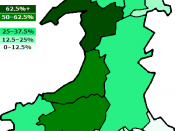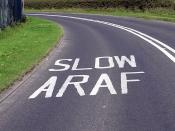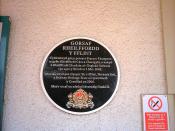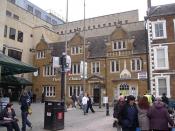Welsh Culture Wales was conquered by the British in 1282. Even though the Welsh are an English sovereignty, they have managed to maintain most of their native traditions and customs. Some of which I will explain in more detail throughout this essay. National symbols of Wales include the commonly recognized Welsh Red Dragon. Two other easily recognized symbols are the leek and daffodil. It is said that the easiest way to identify a Welsh man is by the fact that he wears a leek (or daffodil) in the band of his hat.
One notable aspect of the Welsh culture is the fact that the Welsh people have maintained their own language. As with any language, there are different dialects in the Welsh language. These differences include vocabulary, pronunciation and grammar. In the Welsh language, these differences are relatively minor. Not so minor, however, are the differences between spoken Welsh and written Welsh.
Written Welsh is much more formal than the commonly spoken forms of the Welsh language. All Welsh schools teach and use both the King's English and Welsh. While it may be accepted to cease using the native language in many cultures, in Wales, it is still required to use Welsh in all classes all the way through college.
While the country of Wales is still ultimately ruled by the United Kingdom, it is also self governed with Welsh being the language spoken in all governmental meetings and communications. Street signs are posted in both languages with some having Welsh names derived from the English names given to streets and locations. The Welsh language has undergone many transformations throughout history. The earliest known form of the Welsh language bears little resemblance to today's spoken language. This form, known as Early Welsh, dates back to about the 6th century. Old Welsh, the 9th thru 11th centuries, is seen in the oldest Welsh poetry. Middle Welsh, 12th thru 14th centuries, is seen in the early manuscripts of the Mabinogion. This form of Welsh may be difficult for modern-day Welsh people to translate. Early Modern Welsh, 14th thru 16th centuries, was used by one of the most famous of all Welsh literary artists Dafydd ap Gwilym. Late Modern Welsh began in 1588 with the Welsh translation of the Bible by William Morgan. This is the Welsh language still spoken today, with many minor changes.
The educational system in Wales is unique in many ways. Following is a year by year breakdown of the Welsh school system.
÷Primary EducationoInfant School or Primary SchoolçReception, age 4 to 5çYear 1, age 5 to 6çYear 2, age 6 to 7 (end of Key Stage One Teacher Assessments)oJunior School or Primary SchoolçYear 3, age 7 to 8çYear 4, age 8 to 9çYear 5, age 9 to 10çYear 6, age 10 to 11 (End of Key Stage Two Tests and Tasks)÷Secondary EducationoMiddle School, High School or Secondary SchoolçYear 7, old First Form, age 11 to 12çYear 8, old Second Form, age 12 to 13çYear 9, old Third Form, age 13 to 14 (End of Key Stage Three Tests and Tasks)oUpper School or Secondary SchoolçYear 10, old Fourth Form, age 14 to 15çYear 11, old Fifth Form, age 15 to 16 (old O-Level examinations, modern GCSE examinations)oUpper School, Secondary School, or Sixth Form CollegeçYear 12 or Lower Sixth, age 16 to 17 (AS-level examinations)çYear 13 or Upper Sixth, age 17 to 18 (A2-level examinations. Both AS-levels and A2-levels count towards A-levels.)Education in Wales emphasizes depth of education rather than breadth. As a result, students in Wales take fewer yet more advanced examinations to advance from one grade level to another. This educational system is also used in England and parts of Ireland.
There are many cultural activities in Wales. As with many parts of the world, people in Wales love their sports. The most prominent sport in Wales is Rugby. As with any culture, food plays a very important part. Some of the traditional foods include Laverbread, a delicacy made from seaweed. Bara brith, a traditional Welsh fruitcake. And Welsh cakes, sweet scone-like snacks made from flour, butter, eggs, sugar and currants.
A traditional gift for young smitten men is the "love spoon". In ancient times, most people were illiterate so writing poetry to the girl you loved was not a possibility. Instead, the men would carve elaborate spoons to show their affection. In today's modern age, these spoons are still given and treasured.
National festivals are held, one of which is the Eisteddfod. The name literally means sitting. This is a festival of literature, music and song. A traditional meeting of artists which dates to at least the 12th century, this present-day format owes its popularity to 18th century revivals of ancient customs. The most important of these festivals alternates between North and South Wales each year and takes place entirely in the native Welsh language. Competitions are held for each of the major areas of artistic expression. Crowns and chairs are awarded and considered a great honor.
One of the first things that come to mind when thinking of the Welsh culture is Druids. This is where the Gorsedd comes into play. The Gorsedd is a community of bards. The literal translation of the word Gorsedd is "throne". The Gorsedd promote literary scholarship and encourage the creation of poetry and music. They are instrumental in the organization of Eisteddfodau. Founded in 1792, their activities are based in practices of the ancient Druids as well as Christian influences. Rank within the Gorsedd can be determined according to what color robe the person is wearing. Ovates wear green robes, bards were blue, and druids wear white. The head of the Gorsedd wears purple and is called an archdruid. Ovates and bards are determined by the passing of an examination in the Welsh language. Druids may only be nominated by existing druids.
Sources: http://en.wikipedia.org/wiki/Culture_of_Waleshttp://www.walesonline.com/info/culture/index.shtmlhttp://www.bbc.co.uk/wales/culture/sites/aboutwales/pages/culture.shtml






